
PREV ARTICLE
NEXT ARTICLE
FULL ISSUE
PREV FULL ISSUE
GORNY & MOSCH AUCTIONS 240-242
Here's a press release on the upcoming October sales of Gorny & Mosch Auctions. Because of the length I've moved this to the
end of our issue. I illustrated several pieces that caught my eye. See the online catalogs for more information and illustrations.
-Editor
Rarities from Northern Greece in forthcoming Gorny & Mosch Auction From October 10-14, 2016 Gorny & Mosch will hold three auctions. Several collections will be on sale, for example, an exquisite collection of coins from Northern Greece, as well as extensive collections of Bavaria, Stolberg, Salzburg, and Russia. From October 10-14, 2016 Gorny & Mosch will hold three fall auctions. As always, the first Auction 240 will offer high-grade ancient coins. The connoisseur will discover an impressive collection of coins from Northern Greece and rarities of the Sasanians and Kushans. Auction 241 offers ancient coins and lots, among them, the remains of the inventory of Münchner Münzhandlung Karl Kress. Auction 242 is dedicated to medieval and early modern coins, and also contains large collections of Bavaria, Stolberg, Salzburg, and Russia. Auction 240 – High-quality Ancient Coins
Greek coins
If you are enthusiastic about classical beauty, you will certainly prefer a tetradrachm from Apollonia Pontica – on which you can spot every detail due to its extremely fine grade. Extremely rare is a Hellenistic tetradrachm from the city of Aenea, which borrowed its name from the legendary founder Aeneas. If you love the powerful archaic style, it’ll be a hard choice this time: Decisions have to be made among staters, tetradrachms and octodrachms from cities like Akanthos, Mende, Neapoli, Enneahodoi and Olynth or from tribes such as the Bisaltae, the Derroni, the Edoni, the Ichnae, and the Orrescii. Let us mention, as an example, a perfectly centered and preserved stater of the Orrescii, which depicts a centaur on its obverse, who is abducting a nymph. After many excellent individual pieces, such as a tetradrachm of the Epirote king Pyrrhus or a stater from Lindos, another main focus of the auction will follow: the Greek-Persian East. An especially interesting piece is a double daric, probably minted between 331 and 328 in Babylon by the satrap Mazaeus. Furthermore, there will be extremely rare tetradrachms of Persis, several perfectly preserved gold Sassanian dinari, for example from Vahram I, of which, from a collection of a Medical Doctor, a very rare drachm will be offered. Exceedingly spectacular is the series of dinari of Kushan Kings, which give a comprehensive insight into their pantheon. By the way, from both, the Collection of Northern Greece and the Collection of a Medical Doctor, specimens in the lower price range will be offered in Auction 241. Roman coins
A sestertius of Titus, depicting the Colosseum, is the outstanding rarity of this auction. But also the very detailed image of the bridge over the Tiber river, which can be found on an as of Septimius Severus, is worth a second look. Also a small series of medallions of the Antonines needs to be pointed out. Even though they are never in a perfect grade, they still constitute great rarities. There are of course numerous aurei in a perfect grade. For example, an aureus of Domitian displaying the mourning Germania, an aureus of Hadrian depicting the Roman she-wolf, an aureus of Pertinax and Septimius Severus, whereas the latter very likely is unique. If you have an interest in rare silver coins, you will also have a choice: for example a denarius, showing the portrait of Iulia Domna on its obverse and those of her sons, Caracalla and Geta, on its reverse. Even rarer is the heavy miliarensis from Siscia of Vetranio. Byzantine coins
Auction 241 – Ancient Coins and Lots
In 1944, in the course of Nazi “aryanization”, Karl Kress took over the Münzhandlung Otto Helbing, at this time owned by Heinrich Hirsch, father of Gerhard Hirsch, who founded the still active Münzhandlung Gerhard Hirsch Nachf. The Kress coin shop was open for business until 1986. The remains of its inventory will now be offered at Auction 241. Partially in individual lots, partially in sensibly assembled lots. Taking a closer look may be worth your while. Gold, silver, bronze and especially silver fractions are available in stately numbers. Occasionally, one encounters cultural historical highly interesting strikings, such as a coin from the Thracian Pautalia, illustrating on its reverse the wealth of the city: A young boy harvests vines, another carries by a sack of silver ore, a little gold panner sits at the river to wash out the precious metal, a fourth boy cuts the abundant grains. And the best: The estimate for this extraordinary coin only amounts to 400 euros. Auction 242 – Medieval and Modern Times
Medieval coins
Aficionados of the Sicilian Middle Ages will be able to choose between four augustales. They are the high point of a small series from that kingdom. German coins
If you like multiple talers, you will be spoilt by choice at Auction 242. Several rare pieces from Brunswick will be auctioned off, such as a 1609 ten taler loeser of Henry Julius of which Duve only knew 6 specimens, or a quadruple taler of Frederick of Celle, minted in 1609 in Clausthal depicting a yearning for peace image. Also worth mentioning is an extremely rare fraction, a threefold mariengroschen, CASSA-coin from 1801, which was struck according to the standard of the convention. Next to many rare specimens and a small series of coins from Halberstadt, a comprehensive Stolberg collection will go over the auction block. Here, the timeline ranges from pre-1377 county strikings up to strikings from the beginning of the 19th century. The top lot is an extremely fine gulden taler, minted in 1560 in Augsburg by Louis II of Königstein and Rochefort. Almost 180 lots of post-1871 coins are to follow. Among them, the finest known specimens of the sought after 3 Mark 1917 “Frederick the Wise”. This is the only specimen of this type which was graded PF66 Ultra-Cameo by NGC and PCGS. Collection Salzburg
Foreign coins, including a large collection Russia
The auction will close with more than 200 lots of Russian coins and medals. Next to rare coins, as the 1720 double ruble from the Moscow mint or – among the copper coins – the 1787 EM Avesta 5 kopecks of Swedish King Gustav III, there are many extremely rare medals which feature official gradings. Take, as an example, a gold prize medal for successful female graduates of Russian nobility, which was awarded in the years after 1800. All catalogs may be ordered at Gorny & Mosch, Giessener Münzhandlung, Maximiliansplatz 20, D-80333 Munich, phone +49 / (0)89 / 24 22 643-0, fax +49 / (0)89 / 22 85 513. The catalogs are also available online at https://auktionen.gmcoinart.de/. By the way, it will be worth your while to consult our online catalogs online, since images of many coins and medals, which didn’t find a spot in the printed catalogs, are available there. 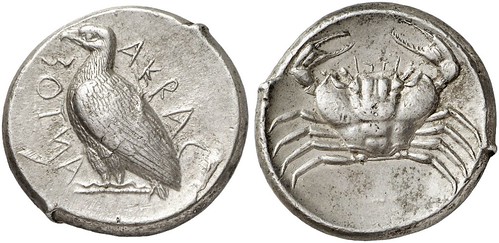
Lot 24: ACRAGAS (Sicily). Tetradrachm, ca. 460-450/446. Extremely fine. Estimate: 20,000,- euros 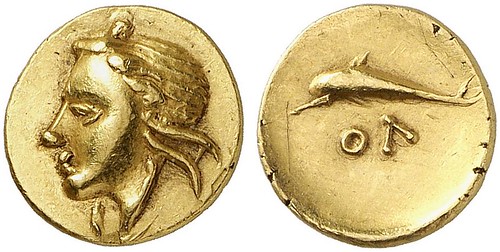
Lot 59: OLBIA (Sarmatia). Quarter stater, ca. 360-320. Extremely fine. Estimate: 6,000,- euros Lot 64: APOLLONIA PONTICA (Thrace). Tetradrachm, 400-350. Extremely fine. Estimate: 15,000,- euros Lot 81: AENEA (Macedonia). Tetradrachm, mid-4th cent. Almost extremely fine. Estimate: 12,000,- euros 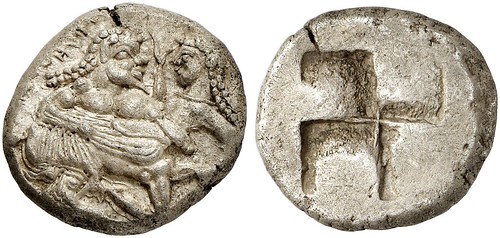
Lot 111: ORRESCII (Macedonia). Stater, ca. 500-480. Extremely fine. Estimate: 22,000,- euros Lot 166: EPIRUS. Pyrrhus, 297-272. Tetradrachm, Locroi Epizephyrioi. Extremely fine. Estimate: 20,000,- euros 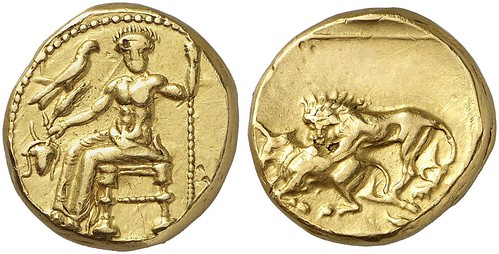
Lot 270: BABYLON. Mazaeus, 331-328. Double daric. Very fine. Estimate: 15,000,- euros Lot 285: SASANIDS. Vahram I, 273-276. Dinar, Ctesiphon. Almost extremely fine. Estimate: 18,000,- euros Lot 303: KUSHAN. Huviska, 151-190. Dinar. Extremely fine to FDC. Estimate: 10,000,- euros Lot 344: PERGAMON (Mysia). Septimius Severus and Iulia Domna, 193-211. AE- medallion. Rv: detailed depiction of sacrifice in front of the emperor’s statue. Extremely fine. Estimate: 1,500,- euros Lot 469: TITUS, 79-81. Sestertius, 80-81, Rome. Av.: Colosseum. Very fine. Estimate: 60,000,- euros Lot 472: DOMITIAN, 81-96. Aureus, 90-91, Rome. Rv: Germania. Extremely fine. Estimate: 20,000,- euros Lot 509: ANTONINUS PIUS, 138-161. AE-medallion, after 142. Very fine. Estimate: 12,500,- euros Lot 527: PERTINAX, 192-193. Aureus, 193, Rome. Extremely fine. Estimate: 40,000,- euros Lot 532: SEPTIMIUS SEVERUS, 193-211. Aureus, after 210, Rome. FDC. Estimate: 50,000,- euros Lot 534: SEPTIMIUS SEVERUS, 193-211. As, 208, Rome. Rv: Tiber bridge. Extremely fine. Estimate: 15,000,- euros 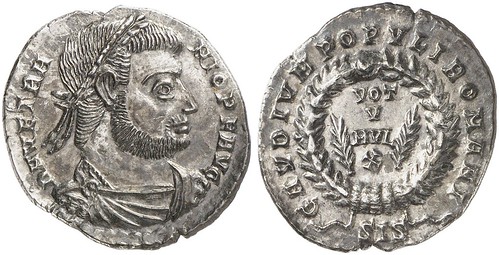
Lot 584: VETRANIO, 350. Heavy miliarense, Siscia. Extremely fine. Estimate: 20,000,- euros Lot 624: EIRENE, 797-802. Solidus, Syracuse. FDC. Estimate: 5,000,- euros Lot 1088: IMITATION. After Eirene, 797-802. “Solidus”, unknown mint. Very fine. Estimate: 250,- euros 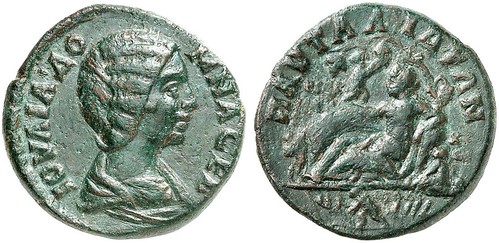
Lot 1789: PAUTALIA (Thrace). Iulia Domna. AE. Rv: the wealth of the city of Pautalia. Good very fine. Estimate: 400,- euros Lot 4003: ARNSTEIN. Walter II, 1135-1176. Bracteate. Very rare. Very fine to extremely fine. Estimate: 600,- euros Lot 4129: SICILY. Frederick II, 1197-1220- 1250. Augustalis no date, Messina. Very rare. Very fine. Estimate: 7,500,- euros Lot 4189: BAVARIA. Maximilian I, 1598-1651. Taler 1627, Heidelberg. Extremely rare. Very fine. Estimate: 5,500,- euros Lot 4315: BAVARIA. Maximilian II, 1848-1864. Double taler 1859, Munich. Graded NGC PF65. Proof. Estimate: 10,000,- euros Lot 4344: BRUNSWICK-WOLFENBÜTTEL. Henry Julius, 1589-1613. Löser of 10 taler 1609. Very rare. Very fine to extremely fine. Estimate: 25,000,- euros 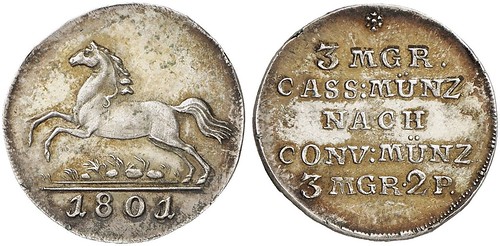
Lot 4364: BRUNSWICK-CELLE / CALENBERG. George III, 1760-1820. 3 mariengroschen CASSA-coin 1801. Extremely rare. Extremely fine to FDC. Estimate: 5,000,- euros Lot 4500: REGENSBURG. 4 ducats 1664. Extremely rare. Almost FDC. Estimate: 25,000,- euros 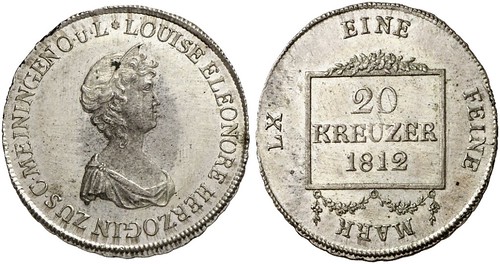
Lot 4566: SAXE-MEININGEN. Luise Eleonore as tutor. 20 kreuzer 1812, Saalfeld. Only 4 known specimens. FDC. Estimate: 12,000,- euros Lot 4623: STOLBERG. Louis II of Königstein and Rochefort, 1535-1571. Guldentaler 1560, Augsburg. Extremely rare. Extremely fine. Estimate: 6,000,- euros 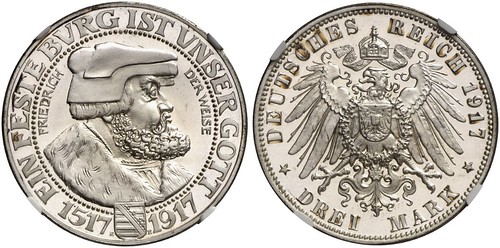
Lot 4769: GERMAN EMPIRE. Frederick August III, 1904-1918. 3 mark 1917 E. “Frederick the Wise”. Graded NGC PF66 Ultra Cameo. Probably the best known specimen. Proof. Estimate: 100,000,- euros Lot 5092: SALZBURG. Leonhard of Keutschach, 1495-1519. Guldiner 1522. Very rare. Very fine. Estimate: 2,500,- euros Lot 5280: MURBACH and LÜDERS. Leopold William of Austria, 1626-1662. Ducat 1651 or 1631(?), Guebwiler Mint(?). Unedited, unique. Extremely rare. Very fine. Estimate: 30,000,- euros Lot 6009: RUSSIA. Peter I, 1682/1689-1725. 2 rubel 1720, Moscow. Very rare. Good extremely fine. Estimate: 20,000,- euros Lot 6057: RUSSIA. Catherine II, 1762 -1796. 5 kopecks 1787 EM. Avesta coinage of Swedish King Gustav III. RR! VF-EF, Estimate 2,000,- euros Lot 6215: RUSSIA. Alexander I, 1801-1825. Gold prize medal 1806 (the year of awarding) for a successful female graduate of Russian nobility. Estimate: 15,000,- euros Wayne Homren, Editor The Numismatic Bibliomania Society is a non-profit organization promoting numismatic literature. See our web site at coinbooks.org. To submit items for publication in The E-Sylum, write to the Editor at this address: whomren@gmail.com To subscribe go to: https://my.binhost.com/lists/listinfo/esylum All Rights Reserved. NBS Home Page Contact the NBS webmaster 
|